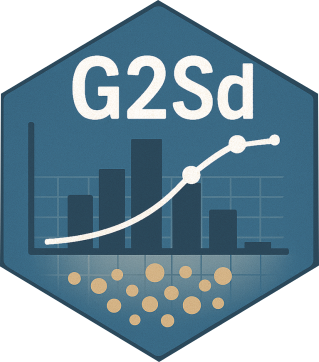
The hardware and bandwidth for this mirror is donated by METANET, the Webhosting and Full Service-Cloud Provider.
If you wish to report a bug, or if you are interested in having us mirror your free-software or open-source project, please feel free to contact us at mirror[@]metanet.ch.

G2Sd provides comprehensive descriptive statistics and physical descriptions of sediment based on grain-size distribution data obtained from metric or phi sieves.
The G2Sd package is an evolution of the Gradistat v.4.0 macro for MS Excel initially developped by Blott and Pye (2001) for phi sieves and Laser granulometer. This package is suited to analyse data obtained from metric (micrometer) or phi sieves. The user is required to input the weight of sediment retained on sieves spaced at any metric or phi intervals. Statistics are calculated using arithmetic and geometric Method of Moments (micrometer) and using logarithmic Folk and Ward (1957) Method (phi scale): mean, standard-deviation, skewness, kurtosis. The mode(s) is(are) determined graphically by the user (with a maximum of 4 modes). The determination of the mode is optional (no determination by default). Several percentiles and common index are calculated: D10, D50, D90, D90/D10, D90-D10, D75/D25, D75-D25, Trask(So) Index, Krumbein(Qd) Index. Physical description of texture, sorting, skewness or kurtosis are provided as such as the sediment name after Folk (1954). Are also included the percentage of particules falling into each predefined size fraction, modified from Blott and Pye (2001) scale, Udden (1914) and Wentworth (1922). There are three main functions :
granstat is a function which provides all results
organized in two ways: a complete matrix (by default) or by separate
items;granplot is a function which provides a histogramm with
a cumulative percentage curve;grandistrib is a function which provides a barplot of
the different fractions composing the sedimentThe package also includes an interactive Shiny web application for user-friendly analysis and visualization of grain-size data, featuring modern UI with plotly interactive plots.
The easiest way to install G2Sd is from CRAN:
install.packages("G2Sd")To install the development version from GitHub:
# Install remotes package
install.packages("remotes")
# Install G2Sd from GitHub
remotes::install_github("gallonr/G2Sd")After installation, load the package:
library(G2Sd)library(G2Sd)
# Load example dataset
data(granulo)
# View the structure of the data
head(granulo)The granulo dataset contains grain-size data from 21
sediment samples with AFNOR sieve sizes (in micrometers).
Calculate grain-size statistics for a single sample:
# Analyze the first sample (column 2)
result <- granstat(granulo[, 2, drop = FALSE])
# View the complete results
print(result)This will provide: - Mean, standard deviation, skewness, and kurtosis (arithmetic, geometric, and Folk & Ward methods) - Key percentiles (D5, D10, D16, D25, D50, D75, D84, D90, D95) - Sediment classification (Folk 1954) - Textural descriptions and fraction percentages
Create a histogram with cumulative curve:
# Plot the grain-size distribution for sample 1
granplot(granulo, 1)
# Plot with custom title
granplot(granulo, 1, main = "Station A - Grain Size Distribution")Display the distribution of sediment fractions:
# Show sediment fractions for sample 5
grandistrib(granulo, 5)
# This creates a barplot showing percentages of:
# - Gravel, sand (very coarse to very fine), silt, and clay fractionsAnalyze all samples in the dataset:
library(purrr)
library(dplyr)
# Analyze all samples using purrr::map
results_list <- granulo |>
select(-1) |> # Remove the size column
map(~ granstat(data.frame(.x)))
# Extract mean grain sizes for all samples
mean_sizes <- results_list |>
map_dbl(~ .x$stat$arith$mean.arith.um)
print(mean_sizes)
# Or using traditional approach without additional packages
results_list <- lapply(2:ncol(granulo), function(i) {
granstat(granulo[, i, drop = FALSE])
})
mean_sizes <- sapply(results_list, function(x) x$stat$arith$mean.arith.um)library(G2Sd)
# Load data
data(granulo)
# Analyze sample 3
sample_stats <- granstat(granulo[, 3, drop = FALSE])
# Display key statistics
cat("Mean grain size (arithmetic):", sample_stats$stat$arith$mean.arith.um, "µm\n")
cat("Mean grain size (Folk & Ward):", sample_stats$stat$fowa$mean.fw.um, "µm\n")
cat("Sediment type:", sample_stats$stat$fowa$sediment, "\n")
cat("Texture:", sample_stats$sedim$texture$texture, "\n")
# Visualize the distribution
granplot(granulo, 3)
# Show fraction composition
grandistrib(granulo, 3)## Interactive Shiny Application
G2Sd includes a powerful interactive web application built with Shiny, allowing you to analyze and visualize grain-size data through an intuitive graphical interface.
The Shiny application provides:
To start the Shiny application:
library(G2Sd)
# Launch the interactive application
granstat(web_interface = TRUE)This will open the application in your default web browser. The interface includes:
The application accepts CSV or TXT files with: - Sieve sizes in micrometers as row names - Sample names as column headers - Weight retained on each sieve in the cells
Example format:
Size,Sample1,Sample2,Sample3
2000,5.2,3.1,7.5
1000,12.5,8.3,15.2
500,25.8,20.1,28.6
...For detailed documentation on each function:
?granstat # Statistical analysis
?granplot # Histogram and cumulative curve
?grandistrib # Fraction distribution
?granulo # Example dataset descriptionTo launch the interactive Shiny application:
granstat(web_interface = TRUE)If you use G2Sd in your research, please cite:
citation("G2Sd")Contributions, bug reports, and feature requests are welcome! Please feel free to open an issue or submit a pull request on GitHub.
Blott, S., Pye, K. 2001. Gradistat: grain size distribution and statistics package for the analysis of unconsolidated sediment. Earth, Surface Processes and Landforms 26, 1237-1248
Folk, R.L. 1954. The distinction between grain size and mineral composition in sedimentary-rock nomenclature. Journal of Geology 62, 344-359
Folk, R.L., Ward, W.C. 1957. Brazos River bar: a study in the significance of grain size parameters. Journal of Sedimentary Petrology 27, 3-26
Krumbein, W.C., Pettijohn, F.J. 1938. Manual of Sedimentary Petrography. Appleton-Century-Crofts, New-York
Udden, J.A. 1914. Mechanical composition of clastic sediments. Bulletin of the Geological Society of America 25, 655-744
Wentworth, C.K. 1922. A scale of grade and class terms for clastic sediments. Journal of Geology 30, 377-392
GPL-3
Maintainer: Regis K. Gallon (CNAM-Intechmer) - regis.gallon@lecnam.net
These binaries (installable software) and packages are in development.
They may not be fully stable and should be used with caution. We make no claims about them.